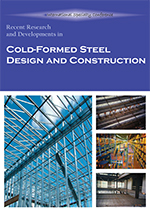Session Dates
14 Aug 2008 - 15 Aug 2008
Abstract
A study investigating dynamic characteristics of full-scale floor systems was performed for several laboratory-constructed and in situ floors. Floors were constructed with cold-formed steel joists and designed for residential mid-rise applications. Typical construction details including span, subfloor, topping, strongback and framing condition were varied, and their influence on fundamental frequency, damping ratio and deflection at mid-span compared. Changes in construction details which significantly increased floor mass, regardless of added stiffness, were found to lower the fundamental frequency. Adding a strongback with restrained ends provided a significant increase in fundamental frequency, stiffness and damping ratio. Laboratory tested floor systems were generally found to be the worst-case scenario for natural frequency and damping ratio.
Department(s)
Civil, Architectural and Environmental Engineering
Research Center/Lab(s)
Wei-Wen Yu Center for Cold-Formed Steel Structures
Meeting Name
19th International Specialty Conference on Cold-Formed Steel Structures
Publisher
Missouri University of Science and Technology
Document Version
Final Version
Rights
© 2008 Missouri University of Science and Technology, All rights reserved.
Document Type
Article - Conference proceedings
File Type
text
Language
English
Recommended Citation
Davis, B. W. and Xu, L., "Vibration Performance of Lightweight Floor Systems Supported by Cold-formed Steel Joists" (2008). CCFSS Proceedings of International Specialty Conference on Cold-Formed Steel Structures (1971 - 2018). 1.
https://scholarsmine.mst.edu/isccss/19iccfss/19iccfss-session6/1
Vibration Performance of Lightweight Floor Systems Supported by Cold-formed Steel Joists
A study investigating dynamic characteristics of full-scale floor systems was performed for several laboratory-constructed and in situ floors. Floors were constructed with cold-formed steel joists and designed for residential mid-rise applications. Typical construction details including span, subfloor, topping, strongback and framing condition were varied, and their influence on fundamental frequency, damping ratio and deflection at mid-span compared. Changes in construction details which significantly increased floor mass, regardless of added stiffness, were found to lower the fundamental frequency. Adding a strongback with restrained ends provided a significant increase in fundamental frequency, stiffness and damping ratio. Laboratory tested floor systems were generally found to be the worst-case scenario for natural frequency and damping ratio.



